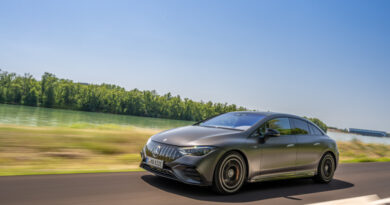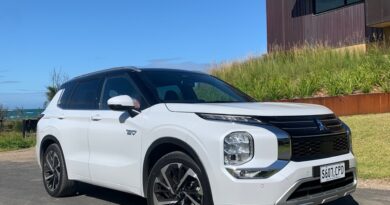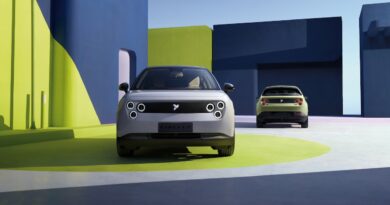2025 Geely Galaxy Starship 7 EM-i Review: PHEV family SUV poses a challenge to BYD Sealion 6, Toyota RAV4
Among the many Chinese brands that have – or soon will – arrive in Australia, Geely is one worth paying particular attention to.
There’s a size and ambition here that suggests while many will falter it will persevere. So far we’ve only got the electric Geely EX5 and its cut-throat pricing to really support that hypothesis, but more models are coming.
The first of them should be the Geely Galaxy Starship 7 EM-i. It’s a plug-in hybrid five-seat medium SUV freshly on-sale in China and there have already been plenty of hints it’s headed our way as soon as this year.
READ MORE: Yet another Chinese Toyota Prado Fighter! Geely Galaxy Cruiser electric 4×4 can crab walk, jump over obstacles, float and could come to Australia
READ MORE: EV price parity is here: Bargain Geely EX5 electric SUV priced to thrill in Australia
READ MORE: China’s Geely launches new electric brand Galaxy
Slotting into Australia’s biggest selling new vehicle segment, it will be a logical rival for fellow Chinese plug-in hybrids like the BYD Sealion 6, the Jaecoo J7 SHS, Haval H6GT PHEV and Leapmotor C10 REEV, as well as the Mitsubishi Outlander PHEV and the Toyota RAV4 regular hybrid.
EV Central recently had the chance to drive it oh-so briefly in China – like just a couple of minutes around some witches hats – and check over its cabin and features.
So let’s check it out.
2025 Geely Galaxy Starship 7 EM-i price and equipment
In China this vehicle is called the Xingjian 7, which translates to Starship 7. Galaxy is a new division of the Geely Auto brand business (which is part of the umbrella Zhejiang Geely Holdings that also owns Volvo, Polestar, Zeekr, Lotus and more) that focusses on what China calls new energy vehicles (NEVs). That means they have some form of electrification with a plug to recharge externally.

Galaxy is the designated export source for the Geely brand, although that part of the name gets dropped. In fact, apart from being called a Geely, we have no idea what the Xingjian/Starship 7 will be called in Australia. For the purposes of this article we’ll just keep calling it the Starship.
In China there are five Starship trims, two battery sizes and one powertrain that combines a 1.5-litre naturally aspirated petrol engine with a single e-motor to power the front wheels via a single speed reduction gear.
The underpinning platform is shared with the slightly smaller EX5, while exterior sheetmetal is different but obviously from the same rounded design school.
Chinese pricing stretches from around $23,000 to $30,000, which is substantially below what we will see here. But given the excellent pricing of the EX5 and the positioning of the Starship 7’s key local rivals, a pricing range between $40,000 and $50,000 depending on the spec seems a logical guesstimate.
Our Starship 7 experience was with the flagship Pilot Edition, so we’ll focus on that in terms of equipment and spec.
It comes with the larger 19.09kWh battery option (the smaller one is only 8.05kWh) that delivers a guesstimated real-world EV range of 100km and combined range of 1000km. Ratings based on the generous CLTC standard are higher. The DC recharge rate is a maximum 36kW.

Equipment includes a 10.2-inch digital instrument panel, 14.6-inch infotainment touchscreen with embedded satellite-navigation and a 13.8-inch head-up display.
Other features include 19-inch alloy wheels, a panoramic sunroof, a power tailgate, some indeterminate form of leather-ish trim, climate control air-conditioning, 50W cooled wireless phone charging, a 16-speaker audio system including headrest speakers and V2L and V2V (vehicle-to-vehicle) charging.
Front seats are powered, vented and heated and offer 14-point massaging. They are described on the Geely Galaxy website as “marshmallow”. Apparently that is a design feature. They did feel pretty soft and didn’t offer that much in the way of cornering support.

In China there’s a heap of high-end driver assist systems standard. Usually, not all of this stuff makes it to Australia. Other safety equipment includes six airbags and a pin-sharp 360-degree camera that provides plenty of different views.
While we were with Geely in China it became obvious how proud the company was of achieving a five-star ANCAP rating for the EX5. You can bet your bottom dollar the same ambition is held for the Starship 7.
2025 Geely Galaxy Starship 7 EM-i: What we think
The Starship 7 is a big vehicle for its class and, just as importantly, exploits that size properly with a generously spacious interior.
There is enough room in the rear for two tall passengers and three at not too much of a squeeze thanks to a middle seat that’s quite comfy and a flat floor. Plenty of creature comfort back here too, including adjustable air vents and USB ports.
This is family-friendly space, reinforced by the 528-litre boot (including 100 litres under the floor), expanding to 2065 litres with the rear seats folded down.

Up-front, its noticeable just how touchscreen-centric the Starship 7 in terms of fundamental controls. Obviously a common Chinese theme and one we’re not at all enamoured by.
But there is decent storage, aided by moving the gear selector away from the centre console to the steering column. The steering wheel is a squircle that adjusts for reach and rake.
The overall interior quality looks and feels high and has a modern, premium vibe – it’s too minimalist to be called luxury – typical of Chinese cars.

So to the driving, well what there was of it. A couple of laps around some witches hats makes concrete assessment impossible.
But the NordThor EM-i powertrain – as it is dubbed – felt strong, whisking away from a standing start in EV mode before the petrol engine chimed in as the speed rose to a heady 60-70km/h.
It’s very apparent this is a quiet powertrain, even when the engine is running either to drive wheels or recharge the battery.
What our twirl around the cones also revealed was light, lifeless steering (in any of multiple modes available) and a soft independent suspension set-up that promoted plenty of body roll and early-onset front wheel sliding (understeer) even at our pedestrian cornering speeds.

We suspect the tune of the dynamics reflects the reality of low-speed Chinese urban driving. For Australia some more steering weight needs to be added and some more discipline injected into the springs and dampers.
Geely has indicated its vehicles will be retuned for export markets, so hopefully the Starship 7 gets some treatment.
2025 Geely Galaxy Starship 7 EM-i: Verdict
Based on this brief taste the Starship 7 has the basic ingredients to be a competitive player in the medium SUV segment.
But – and it’s a big but – there’s a bunch of things it needs to achieve to be taken seriously.
It needs to drive well on Aussie roads, not be too frustrating to operate, not have too many annoying bing bongs and driver assist intrusions (something the EX5 has been criticised for) and be priced compellingly.
Those are all big unknowns and therefore it’s pointless to issue a score for the Starship 7 as we’ve briefly encountered it. That can wait till it arrives in Australia and we get more time to understand it better.
SCORE: TBA
2025 Geely Galaxy Starship 7 EM-i price and specifications
Price: $40,000-$50,000 (estimate)
Basics: PHEV, 5 seats, 5 doors, medium SUV, FWD
Range: 1000km combined (estimate)
Battery capacity: 19.09kWh
Battery warranty: TBA
Energy consumption: TBA
Fuel consumption: 3.75L/100km (CLTC)
Powertrain: 1.5-litre four-cylinder petrol, 82kW/136Nm
Motors: 1 front, 160kW/262Nm
AC charging: TBA
DC charging: 36kW
0-100km/h: 7.5 seconds




